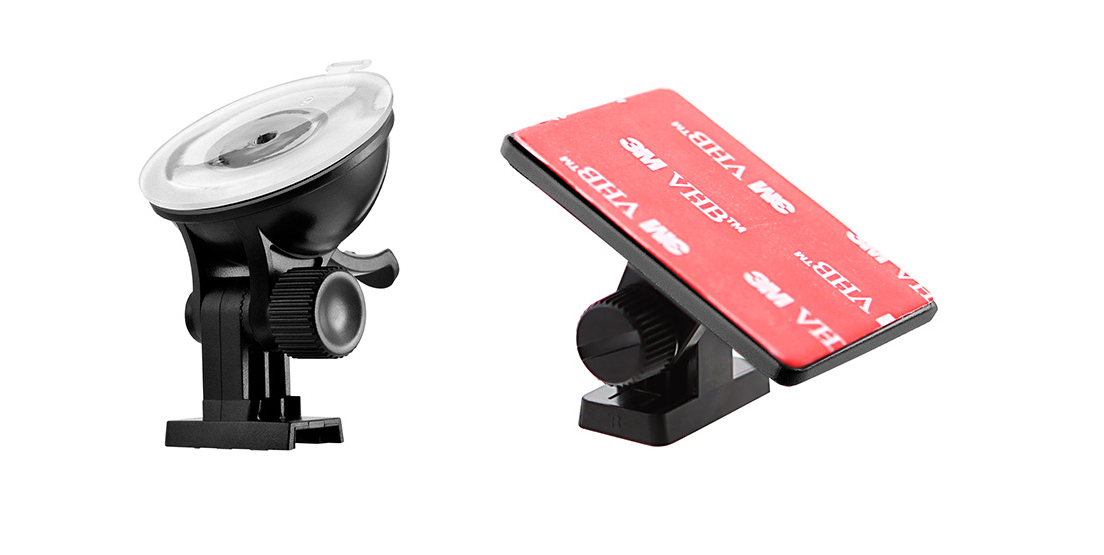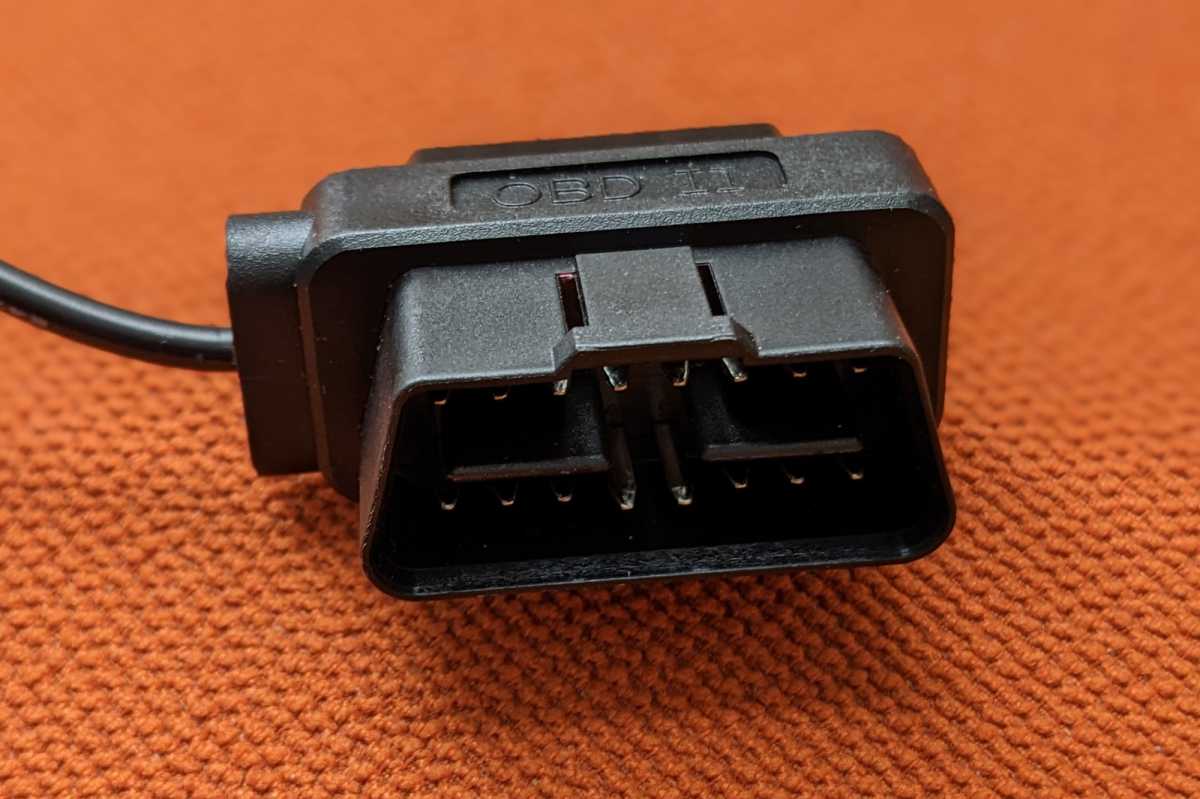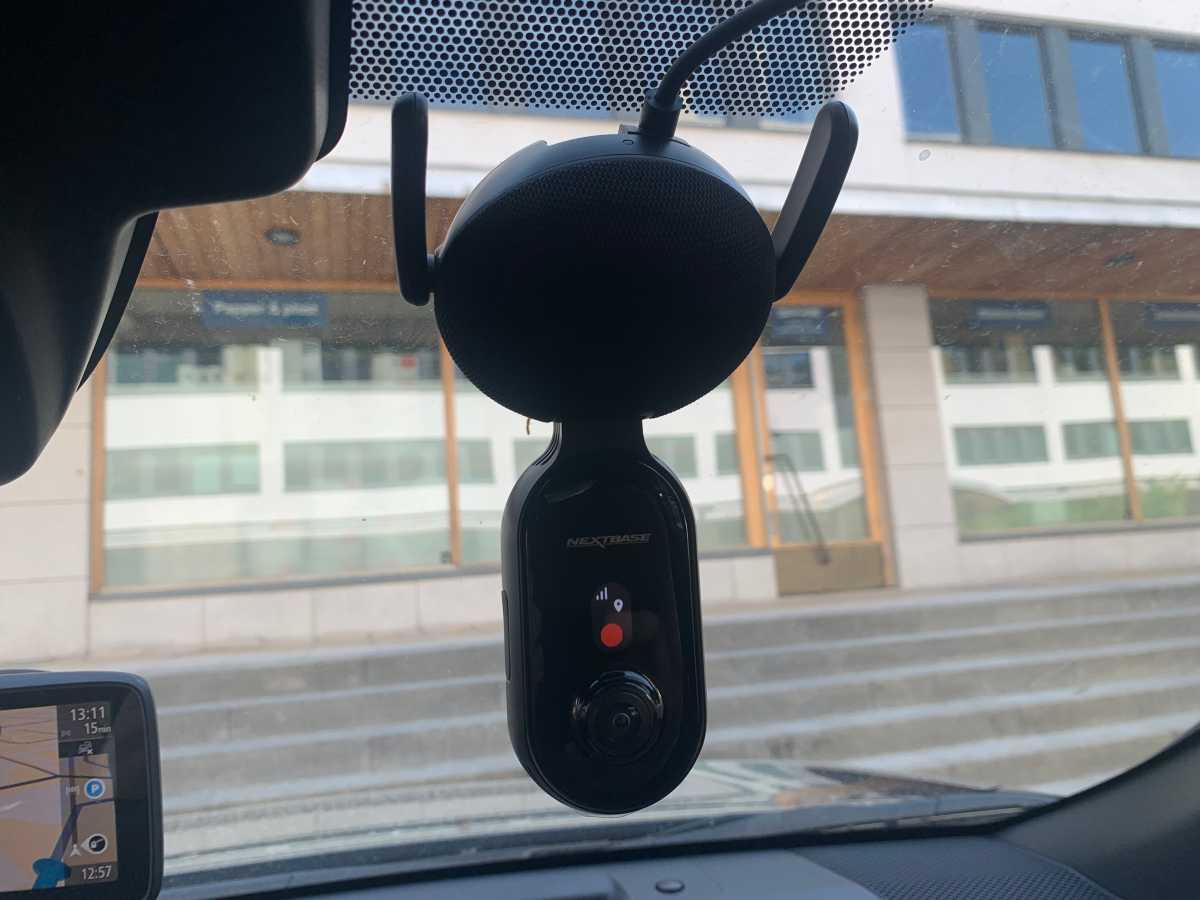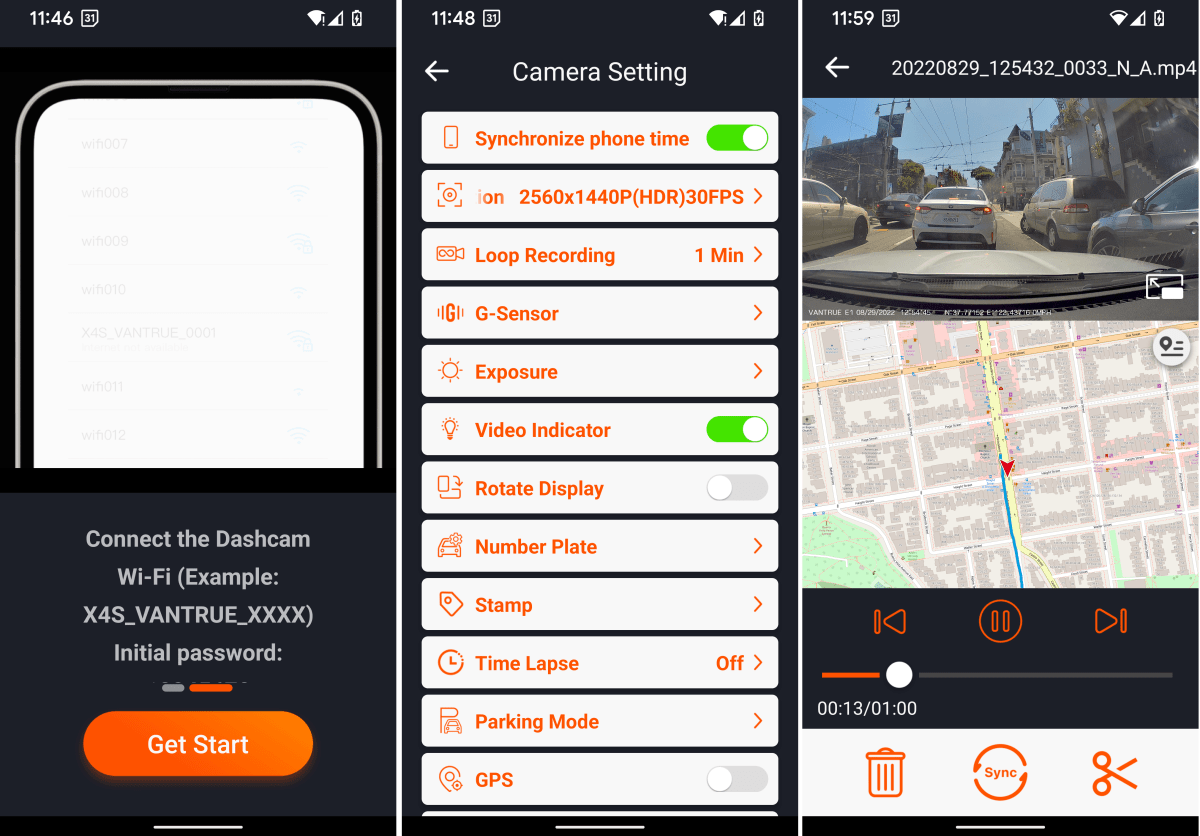Dash cams have come a long way from the rather primitive 480p products that were state-of-the-art when we first began our coverage eight years ago. These days, multi-channel front/interior/rear models abound, and capture quality is vastly improved — including 4K resolution.
Amenities such as phone connectivity, driver alerts, and voice commands are now common, and some dash cams will even upload videos to the cloud or call 911.
What follows are the criteria and test methodology we employ as we examine, install, and bang on one of these puppies in our test vehicle.
Further reading: The best dash cams
Suitability to task: Single or multiple channels
Of course, the first thing we consider in a dash cam system (some have multiple cameras) is suitability to task. If you’re driving a semi, you’ll only need front coverage, or a far more complex system than we generally review — one that can cover the obscured areas to the side and rear. If you’re a ride-giver you’ll want coverage of the interior, and likely out the back of the vehicle as well.
A single-channel dash cam is always front-only. Dual-channel dash cam systems can be front/interior or front/rear. Three-channel systems cover the front, interior, and rear. We have seen the occasional four-channel system that attempts 360 coverage, but it’s not common.
Dash cam features we look for
Vendors always try to distinguish their products via clever or ground-breaking features. Other vendors tend to catch up quickly once something unique and sell-able is introduced. However, the basics are what we value most. Here’s what we look for:
The essentials
— At least 1080p resolution. A resolution of 1440p or 2160p often (but not always) offers better detail, but chews through storage more rapidly (as do multiple cameras) and requires fast TF cards or internal (mostly eMMC) storage.
— Good optics and processing. Higher resolution and a high-end sensor mean nothing if the lens and post-processing aren’t up to snuff. We’ve seen 4K captures that are worse than top-notch 1080p captures.
— Linked to resolution are compression and storage requirements. 4K video can take up a lot of space. Less so with h.265 than with h.264. Most vendors offer both methods since, while h.265 saves space, it’s not as compatible with older playback devices. Dash cams vary in storage support, such as what capacity Micro SD/TF card they will accept, or the amount of internal memory, if that’s what they employ, so we take that into consideration as well.
— GPS. Global positioning data can pinpoint the location of an accident, as well as provide mapping data of your drives. I’ve used it to locate a pleasant eatery in the mid-west I’d forgotten the location of.
The less essential
— Voice control and alerts are nice features that help you keep your eye on the road.
— Bad-driver hand-holding features, err… driving aids, such as lane-departure warnings, are far less important to us. Not only are they not particularly smart in many cases, but they can distract you at the wrong time. Do us all a favor, and if you find these useful, let someone else drive.
— On the other hand, stop-sign and speed-zone warnings might save you some money, if they don’t distract. Of course, if you always abide by the posted instructions, you don’t need these either.
Dash cam mounting methods
Dash cam mounts come in two flavors: semi-permanent adhesive (sticky), and slightly less “semi-permanent” suction mounts. You can almost always remove the camera from it’s base so that’s rarely an issue. But occasionally you can’t, and the exceptions tend to be high-end cameras. Go figure. Sticky mounts sometimes come with easier-to-remove, but still-sticky film adhesive.
Which style you prefer largely depends on your circumstances. If you intend to use the same dash cam in multiple vehicles, a suction mount is best. Otherwise, a sticky mount (some cameras come with a couple of base plates) is less likely to come loose.

If you’re parked in locations where theft is less likely than damage, then leaving your dash cam in the car can be beneficial, waking up (constant power required) and capturing damage that may occur when you’re not in the car. If the camera is cloud-capable, it might even manage to upload images before a thief can unplug or remove it.
One thing most vendors skip (we’ve only seen two) is a removable rear camera. Parking on the street in San Francisco, I often long for this, though honestly, most thieves don’t look for stuff on your back window. At least that’s the working theory as to why I have yet to have one stolen, despite my leaving the car unlocked and it having been visited several times.
Unless it’s something special (magnetic, etc.) we don’t award or subtract brownie points for the mounting system. You quite often have a choice when ordering so mull it over.
Power source
How a dash cam is powered is something that weighs more heavily into our evaluation than mounts — the power method makes a difference in both convenience and cabin clutter.
There are three possible sources for dash cam power: the auxiliary (cigarette lighter) port, the OBDII port, or a hardwire kit that taps into your car’s wiring. There are also adapters that pull juice from powered mirrors, but we’ve never seen a dash cam vendor provide one, as the required connector varies by auto manufacturer.

Grabbing power via the auxiliary port (nee cigarette lighter) is the most common and easiest method, but quite often it also means a cable running up the center of the dash that’s hard to hide. Additionally, most auxiliary ports lose power when you turn off the car.
Hardwire kits allow you to hide the cable more easily, but require a lot more time and tapping the wires under your dash. If installed correctly, a hardwire kit provides a constant power source for parking surveillance. Cameras that offer that will, or should, sense a low-battery condition and power all the way down in response. If they don’t, we dock points.
An OBDII cable is the most elegant solution, simply plugging into that diagnostic port and also providing constant power. The OBDII port is generally found in a less-exposed location, most often in the driver’s side foot well. Most OBDII cables provide a pass-through port so you can still connect diagnostic equipment without cutting power to the dash cam.
The connector port on the camera is also something we consider. Non-proprietary connector types such as Type-C are much easier to source than proprietary coax connectors and the like. You can even find Type-C cables at gas stations these days.
Proprietary cables may require a visit to the dash cam vendor’s site to replace, and might be more expensive, might take a while to get, or even worse, be unavailable. Beyond that, cable type is a relatively minor concern rating-wise.
Size and build quality
There are laws in some states concerning objects that obstruct your view through the windshield. Most cameras will fit nicely, if not completely, behind your rear view mirror, but we do like small and unobtrusive. Small is also less obvious to thieves. That said, some of our favorite, and most capable cameras are on the large side.

Nextbase’s rather large and intrusive but highly capable IQ dash cam.
Jan Sandbladh
The reason we consider build quality should be obvious. You don’t want something that breaks when you drop it during the mounting process, and a certain amount of heft is indicative of the general concern for quality. On the other hand, you don’t want something too heavy that strains the mount so that it parts from your windshield.
Then there’s heat shedding. We inspect the camera for adequate ventilation. We’ve seen some very good cameras that run a bit warmer than they should due to the relative lack of venting.
Basically, we’re just looking for something inconspicuous and that we think will last for a suitable amount of time (see the Longevity section below).
Capture quality
Capture quality counts by far the most in our evaluation as providing legal evidence is the raison d’etre of dash cams. We of course look for vivid, accurate color; however, detail is by far the most important aspect. Easily legible license plate numbers (along with embedded GPS data) could be the key to reliably establishing the identity of an offending vehicle.
There’s often a large difference in how well a dash cam works in daylight and at night. Night means numerous bright areas imposed on a much darker background, which is harder for a sensor to handle, and much harder to process.
How much you worry about day versus night depends, again, on when you do most of your driving. But the quality of a dash cam’s night captures is by far the most telling aspect when it comes to judging its quality. In other words, if the night captures are good, just about everything else will be as well. If you want to shorten your reading time of our reviews just skip to the night capture evaluation.
Interface, phone apps, and connectivity
While a touch display is always a nice perquisite, we’re generally more interested in how efficiently, ergonomically, and intuitively the settings menus and physical buttons are laid out.
You’re going to be monkeying around in the settings menus often, so how the buttons (or touchscreen) facilitate common operations such as locking a capture (make sure it’s never overwritten), taking a photo, or toggling the microphone or display on/off is weighted heavily.
The ability to respond to voice commands is a plus, and is a virtual necessity for dash cams that lack a display.

For the same reason, phone connectivity is a major plus. The larger displays on today’s cellular devices make adjusting settings considerably easier, while also letting you leave the camera on its mount. (It’s easiest to adjust a dash cam using its own interface when holding it in your hand rather than reaching to the window). Above is the Vantrue phone app interface.
To connect to an app, some sort of wireless is required. Dash cams use either Wi-Fi, Bluetooth, or a combination of both. Wi-Fi allows much faster transfer of files, so if you’re using a display-less dash cam or one that relies on internal memory, it’s basically a necessity, and we’ve never seen one without it. It’s merely a luxury on dash cams with a display and removable memory cards. LTE is also available, but I’ll cover that next.
Though removing an SD/TF card and using a card reader on a computer is easy, we also appreciate the ability to connect the dash cam itself to the computer and offload videos directly from it. Sadly, this isn’t as common as one might hope, despite the vast majority of dash cams using USB connectors of one type or another.
All in all, the more ways to retrieve your videos that a dash cam provides, the better.
Cloud connections and storage
Several dash cams we’ve tested from companies such as the now defunct Owl, Nextbase, Garmin, etc. offer uploads to the web. This can be very handy. Some cameras offer this via integrated LTE, which always requires a subscription, while some offload to your phone then upload using your phone’s connectivity. The latter of course requires connecting your phone to the dash cam and doesn’t offer the immediacy of the dedicated LTE.
We consider LTE dash cams to be almost a separate category, for no other reason than they are expensive to own and operate. But if you have the means, they can be super handy — especially if you’re not the only one driving the vehicle. With LTE, the GPS data can be relayed for tricks such as locating your car, reporting collisions, or making sure that prom date doesn’t wind up at a hotel.
How we test
The first step in testing is of course evaluating the installation, though it’s generally so similar, it’s rarely something that counts heavily for or against. Hand-holding features such as an onscreen alignment routine are great, but they certainly won’t save a camera with bad captures from a low rating.
Once installed, we go for diurnal and nocturnal rides. Most of the video is shot while the vehicle is in motion, though we often use parked shots in the same location so you can more easily compare.
After capturing enough video, we set to inspecting it for quality — primarily detail, color, and stabilization. As previously discussed, quality is not necessarily joined at the hip with resolution, though bigger numbers are generally better. The optics and post capture processing are equally important. As noted, we’ve seen poorly processed 4K captures that are no better, and occasionally worse than competently processed 1080p captures.
We also look at defects and artifacts. These range from the wobblies, where bumps or vibrations induce a shot-through-jiggling-jello effect (a defect common to early GoPros); to shearing, where two half-frames are visible at once; to moire, where details in motion shimmer rather than move smoothly; to severe fish-eye in cameras, with a wider field of view (FOV). Note that these defects have become rarer and rarer over the years.
For night video we check for lens flare from headlights; blown-out bright areas that render dark details invisible; and the level of detail in darker areas.
We also look for how well details are handled in different quadrants. Weak detail to the sides can be induced by cheap optics.

Once again, by far the most important aspect of captures is the amount of detail they provide, which is directly related to the video’s validity as evidence. That said, if you want to document your road trips, the more pleasing the overall quality of the video, the better.
Longevity testing
To be brutally honest, most dash cams aren’t going to last a lifetime. In fact, you’ll be doing well if you get a year from a cheap one and five years from a good one. It’s not always the dash cam’s fault — any piece of operating electronic equipment constantly exposed to direct sunlight will have a hard time of it.
That said, some dash cams run warmer than others, which can’t help longevity when combined with constant exposure to the sun. As noted earlier, we look for lots of ventilation.
Once we’ve finished initial testing, we hand off the dash cam to another individual for long-term testing. Though we rarely report it, end-user feedback gives us an idea of the lifespan of a product, how satisfying it is to use, and in many cases, whether said user even found it useful.
As with many things in life, you don’t need a dash cam until you do. And then, if you don’t have one — it’s too late.
The final rating
To reiterate, our considerations are, in order of appearance: suitability to task, capture detail, capture color quality, physical size and build quality, GPS, connectivity, and price. Yes, as with all the products we review, we factor in how much it costs.
Price won’t change our mind about what’s the actual best tech, but it will result in a bang-for-your-buck opinion. Not everyone needs or can afford the absolute best.



